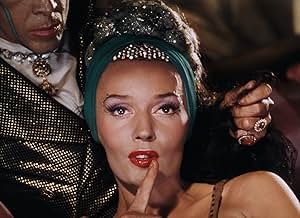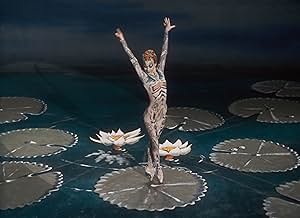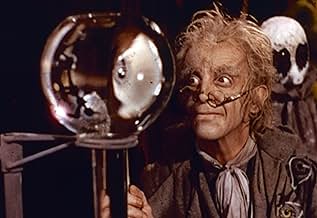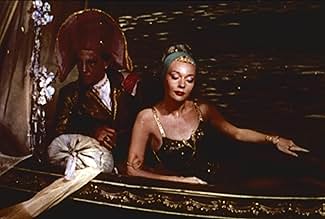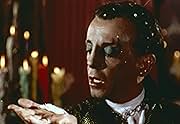अपनी भाषा में प्लॉट जोड़ेंA melancholy poet reflects on three women he loved and lost in the past: a mechanical performing doll, a Venetian courtesan, and the consumptive daughter of a celebrated composer.A melancholy poet reflects on three women he loved and lost in the past: a mechanical performing doll, a Venetian courtesan, and the consumptive daughter of a celebrated composer.A melancholy poet reflects on three women he loved and lost in the past: a mechanical performing doll, a Venetian courtesan, and the consumptive daughter of a celebrated composer.
- 2 ऑस्कर के लिए नामांकित
- 2 जीत और कुल 3 नामांकन
- Giulietta
- (as Ludmilla Tcherina)
- …
- Spalanzani
- (as Leonide Massine)
- …
- Olympia
- (गाने की आवाज)
- …
- Giulietta
- (गाने की आवाज)
- …
- Nicklaus
- (गाने की आवाज)
- …
- Antonia's Mother
- (गाने की आवाज)
- Spalanzani
- (गाने की आवाज)
- …
फ़ीचर्ड समीक्षाएं
But the drawback is that only the tale of Olympia, the mechanical doll, and the ill-fated love affair with the young Hoffmann (played in all three segments by tenor Robert Rounseville) is up to the top standards the film strives to achieve. The other tales of Hoffmann's follies are less interesting, not as easy to understand and not as entertaining or melodious as the Olympia segment.
The final tale of Antonia suffers from the high notes forced upon screeching soprano (Anne Ayars) and the demands of the score which is clearly more tedious than melodious at this point.
Robert Helpmann as the villain in all three tales is excellent and Robert Rounseville as Hoffmann is the only cast member who does his own singing in a strong tenor voice. You may remember him as Mr. Snow in Rodgers and Hammerstein's "Carousel" with Gordon MacRae and Shirley Jones.
But there's no denying the magic of all the visual images on screen which includes the use of puppets and a good mixture of cinema and stage techniques. Opera lovers will find fault with some of the singers but it's hard to see any fault in the dancing which looked magnificent to me.
None of the stories are as involving as "The Red Shoes" and this is one of the weaknesses of the film. The first story is far better than the rest of the tales which makes for an uneven blend of storytelling.
A brilliant use of color and classical music makes it a "must see" for most film buffs.
In the story a poet Hoffman tells in episodic fashion about the many times that he has loved and lost. There have been several films made with such a theme but Hoffman stands well apart because of the Goth-fantastic nature of the narratives. Hoffman, in turn, falls in love with Olympia - a puppet, Guiletta - the temptress of a soul-stealing demon, and Antonia - a singer doomed by fatal consumptive illness.
This narrative is complemented by the brilliantly supportive artistic design of the film. The makers construct a deliberate stage-like ambiance, with the use of representative backdrops, suitably exaggerated props and striking motifs to convey the settings and moods of the various episodes. In this aspect it shares strong kinship with Masaki Kobayashi's period ghost story anthology Kwaidan. You also have the concept of the same actor returning to play different parts in the various episodes of Hoffman's life, the most notable of which is Robert Helpmann who portrays the sinister element in all the episodes (and with his vampiric menacing look, does a terrific job of it, although his motive for evil in the Antonia episode goes unexplained).
The fantastic elements of the plot, color-drenched distinctive look, intricate balletic choreography and excellent fit of all the actors in their roles make Tales of Hoffman a very interesting watching experience on the whole.
One of my caveats with the film is that Hoffman's companion Nicklaus is never properly explained. Who is this woman in man's garb and why is she doing what she does?
क्या आपको पता है
- ट्रिवियाGeorge A. Romero, writer/director of नाइट ऑफ़ द लिविंग डेड (1968) and मृतकों की सुबह (1978) has cited this as his all-time favorite movie, saying that it was the one that originally inspired him to get into filmmaking.
- गूफ़Giulietta's necklace is turned from jewels to wax by Dapertutto, however, in a longer shot, it is briefly shown as jewels again, before a close-up, where it is wax again until Dapertutto changes it back to jewels.
- भाव
Chorus of Students: Some drink, drink, drink, drink, drink: do you hear us about? You lazy lout! We want some beer; we want some wine! Pour out the wine, and drink and drink till morning. Pour out the wine for drinking is divine. It is divine. We want some beer; we want some wine. We want some beer; we want some wine.
- क्रेज़ी क्रेडिटIn the end credits, main actors appear taking curtain calls next to the singers who dubbed them.
- इसके अलावा अन्य वर्जनThe complete 138-minute version was available in 16mm black and white early television prints. The complete 138-minute version was also available in 16mm Kodachrome (color) rental prints. The complete 138-minute soundtrack was available for many years on LP (London Records).
- कनेक्शनFeatured in The Late Show: Michael Powell (1992)
- साउंडट्रैकThe Tales of Hoffmann, A Fantastic Opera
Music by Jacques Offenbach
Arranged by Thomas Beecham (uncredited)
English libretto by Dennis Arundell
From the French text by Jules Barbier
Conductor: Thomas Beecham (as Sir Thomas Beecham Bart.) with The Royal Philharmonic Orchestra
Sung by Robert Rounseville, Dorothy Bond, Margherita Grandi, Ann Ayars (as Ann Ayars), Monica Sinclair, Joan Alexander, Grahame Clifford, Bruce Dargavel, Murray Dickie, Owen Brannigan, Fisher Morgan, Rene Soames, and The Sadler's Wells Chorus
टॉप पसंद
विवरण
बॉक्स ऑफ़िस
- US और कनाडा में सकल
- $91,930
- US और कनाडा में पहले सप्ताह में कुल कमाई
- $23,340
- 15 मार्च 2015
- दुनिया भर में सकल
- $1,40,714
- चलने की अवधि
- 2 घं 13 मि(133 min)
- पक्ष अनुपात
- 1.37 : 1




